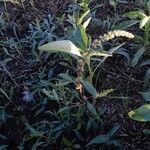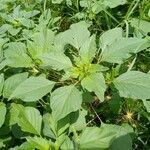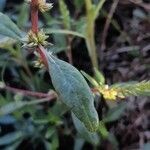Dioecious; erect, 3–10(–20) dm; lvs long-petioled, rhombic-ovate, or rhombic-lanceolate, 3–10 cm; terminal thyrse to 5 dm, 1–1.5 cm thick, the lateral ones shorter or none; bracts mostly 4–6 mm, with heavy, spinosely excurrent midvein; male fls with 5 unequal sep, the outer 3.5–4 mm, acuminate, with conspicuous, long-excurrent midvein, the inner 2.5–3 mm, obtuse or emarginate; female fls with 5 recurved-spatulate sep, the outer 3–4 mm, acute, with the midvein excurrent as a rigid point, the inner 2–2.5 mm, emarginate; fr 1.5–2 mm, circumscissile at the middle; style-branches 2(3); seed 1–1.3 mm, dark reddish-brown; 2n=32, 34. Dry soil; s. Calif. to Okla., Kans., Neb., and La., s. to Mex., and at scattered stations in our range as a weed.
An annual herb which grows to 90 cm high. The stems and leaves are smooth. Leaves have long leaf stalks. They are alternate arranged around the stem. Male and female flowers are on separate plants. The flowers are in cylinder shaped spikes 60 cm long.






